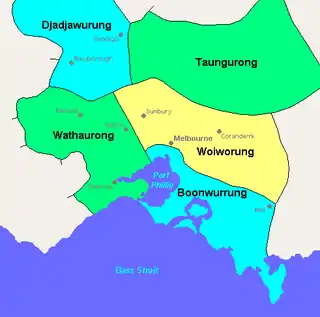Kulin nation
The Kulin nation was an alliance of five Aboriginal nations in south-central Victoria, Australia. Their collective territory extended around Port Phillip and Western Port, up into the Great Dividing Range and the Loddon and Goulburn River valleys.

History
Before British colonisation, the tribes spoke five related languages. These languages are spoken by two groups: the eastern Kulin group of Woiwurrung–Taungurung, Boonwurrung and Ngurai-illam-wurrung; and the western language group of just Wadawurrung.
The central Victoria area has been inhabited for an estimated 40,000 years before European settlement.[lower-alpha 1] At the time of British settlement in the 1830s, the collective populations of the Woiwurrung, Boonwurrung and Wadawurrung tribes of the Kulin nation was estimated to be under 20,000.[1][2][lower-alpha 2] The Kulin lived by fishing, cultivating murnong (also called yam daisy; Microseris) as well as hunting and gathering, and made a sustainable living from the rich food sources of Port Phillip and the surrounding grasslands.[2][3]
Due to the upheaval and disturbances from British settlement from the 1830s on, there is limited physical evidence of the Kulin peoples' collective past. However, there is a small number of registered sites of cultural and spiritual significance in the Melbourne area.[4][5]
People
- Woiwurrung (Woy-wur-rung) – the Wurundjeri people
- Boonwurrung – the Boonwurrung people
- Wathaurong (Wath-er-rung) – the Wathaurong people
- Taungurung (Tung-ger-rung) – the Taungurung people
- Dja Dja Wurrung (Jar-Jar-Wur-rung) – the Djadjawurrung or Djaara people
At certain times of the year, these nations would meet at Yarra Falls to settle disputes, to trade, and to hold corroborees.[6]
Diplomacy
When foreign people passed through or were invited onto tribal lands, the ceremony of tanderrum – freedom of the bush – was performed. This was intended to allow for safe passage and temporary access and use of land and resources by foreign people. It was a diplomatic rite involving the landholder's hospitality and a ritual exchange of gifts.
Notes
- "There is some evidence to show that people were living in the Maribyrnong River valley, near present day Keilor, about 40,000 years ago." (Presland 1997:)
- Presland describes in some detail the archaeological evidence regarding aboriginal life, culture, food gathering and land management, particularly the period from the flooding of Bass Strait and Port Phillip from about 7–10,000 years ago, up to the European colonisation in the 19th century. (Presland 1994, p. )
Citations
- Anon. n.d.
- Presland 1994, p. .
- Pascoe 2017, p. .
- Eidelson 1997, pp. 8–9.
- Eidelson 2001.
- Maunder 2008.
Bibliography
- Anon. (n.d.). "Indigenous connections to the site" (PDF). Archived from the original (PDF) on 31 August 2007.
- Eidelson, Meyer (1997). The Melbourne Dreaming. A Guide to the Aboriginal Places of Melbourne. Canberra: Aboriginal Studies Press. ISBN 0-85575-306-4.
- —— (2001). "The Footballer, First in the league (about James Wandin)". Walks in Port Phillip. A guide to the cultural landscapes of a City (PDF). pp. 35–37. ISBN 0-646-41199-3. Archived from the original (PDF) on 30 October 2008.
- Maunder, Patricia (11 January 2008). "Melbourne dreamtime a reality". The Age. Retrieved 24 April 2019.
- Pascoe, Bruce (2017). Dark Emu. ISBN 978-1-4893-8039-5. OCLC 1089338508.
- Presland, Gary (1994) [First published 1985]. Aboriginal Melbourne: The Lost Land of the Kulin People (Second ed.). Harriland Press. ISBN 0-9577004-2-3.
- —— (1997). The First Residents of Melbourne's Western Region. Forest Hill, Victoria: Harriland Press. ISBN 0-646-33150-7. OCLC 222368168.
Further reading
- Darwin, Norm (1999). "The Loddon Aboriginals". Archived from the original on 28 September 2007.
- Ellender, Isabel; Christiansen, Peter (2001). People of the Merri Merri. The Wurundjeri in Colonial Days. East Brunswick, Victoria: Merri Creek Management Committee. ISBN 0-9577728-0-7. OCLC 52505206.
- Pascoe, Bruce (1997). Wauthaurong Too Bloody Strong: Stories and life journeys of people from Wauthaurong. Apollo Bay, Victoria: Pascoe Publishing. ISBN 094708731-1. OCLC 39078639.